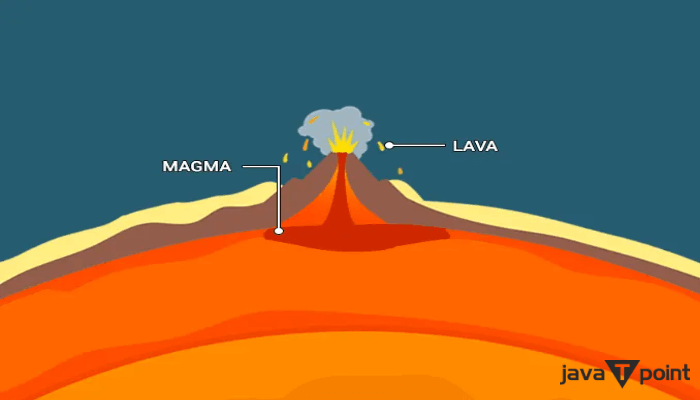Difference between Magma and LavaMagma and Lava are molten rocks with almost the same characteristics. These two are in liquid and semi-liquid form. Magma and Lava are almost the same things, but it is differentiated based on their surface and the location where each is formed or located. Simply put, magma is molten rock present inside the earth's surface, but when it comes out of the vent of a volcano, it is called lava. Let us now briefly discuss both and learn about the notable differences between them. Magma: What is it?The term 'Magma' has been derived from ancient Greek. It is typically a hot liquid form of rock melted at a high temperature. We all know that the earth consists of four layers: the inner core, outer core, mantle, and crust. This Magma is usually formed in the mantle layer, covering the earth's surface. When molten rock is pushed upward and eventually passes through the vent channel, it transforms into igneous rocks and reaches the Earth's surface. Magma is found near mid-ocean ridges or inside the earth's crust. It is liquid or semi-liquid. The reason for being liquid is its high pressure along with the utmost temperature. The dissolved gases are elements of Magma. 
The Magma contains melted solid rocks along with minerals that have been crystallized. The temperature of Magma varies from 1300 to 2400. It is usually at the greatest temperature. The Magma takes time to cool down due to its hot temperature. We consider the location of magma when we measure its temperature. It forms various layers because it is found underground. When magma cools down, the amount of water in it reduces. An example of this is granite which contains about 1% water. Types of MagmaThere are different kinds of Magma. However, the common element included in all magmas is silicon dioxide. It is present in almost all forms of magma. Some of the notable types of magma include Basaltic, Andesitic, and Rhyolite. Let's talk about them in short:
Formation of MagmaNotably, there are two plates found below the earth's surface, namely the oceanic and continental plates. When these two collide, parts of one or both of these plates move into the layer below the core, the mantle. When that oceanic plate drops and sinks, fluid comes out called Magma. Later, this Magma gets collected into chambers. When the chamber gets filled with Magma completely, it creates pressure, and when that pressure reaches its peak, it leads to a volcanic eruption. Lava: What is it?To know about lava, it is important to know about magma which we have already discussed. This is because lava is not a new thing but magma itself. When Magma comes out at the earth's surface due to volcanic eruption, it is called Lava. Lava is an Italic term. It is the hot molten rock in the form of a semi-solid. The minerals such as mica, oxides, and silica get mixed to form Lava. The viscosity is somewhat higher in Lava. Its temperature varies from 1300 to 2200 degrees and is found in oceanic or volcanoes. It cools down more quickly than Magma despite its highest temperature. 
There are some specific classifications of lava based on its composition. Types of Lava Flow
Formation of LavaWe already know the formation of Magma and are aware of the fact that Lava is nothing but Magma only. So, when that Magma gets filled in the chamber, it creates pressure, leading Magma to come out of the surface. When the Magma comes out through the vent, it is known as Lava. Otherwise, it is the same except that Magma is found inside the earth's surface and Lava outside. Difference between Magma and Lava
Facts about Magma and LavaMagma and Lava are the same molten rock. The minerals are similar, except that the Magma constitutes dissolved gases, whereas Lava constitutes silica. Magma has high pressure, due to which it stays in a liquid form. The composition of things determines the behavior of magma as lava. Lava doesn't show the temperature or pressure as magma but highly focuses on the flow. When we compare Magma with Lava, both have viscosity, but Lava is more liquid than Magma and hence has less viscosity. The thickness of both varies. 
Disasters occurring from Magma and LavaEnvironmental Disaster
Health Disaster
Next TopicDifference Between
|
 For Videos Join Our Youtube Channel: Join Now
For Videos Join Our Youtube Channel: Join Now
Feedback
- Send your Feedback to [email protected]
Help Others, Please Share









